The difference between transactional emails and marketing emails
Transactional emails vs. marketing emails - these two types of emails are similar in that they both aim to strengthen your brand image and build customer relationships, but they serve fundamentally different purposes and must be treated as such.
MailerSend is a powerful platform designed specifically for sending transactional emails—automated messages triggered by user actions or events within your application or website.
Please note that configuring MailerSend’s SMTP relay to send regular emails is not recommended, as they may not render or send properly.
In this article, we’ll explain how transactional and marketing emails differ from one another, and why having dedicated email tools for each is the best way to manage your business emails.
What is a transactional email?
Transactional emails are automated emails sent to one recipient triggered by an event or action carried out by the recipient on a business’ website or app. Transactional emails are used for commercial activities such as account activity or purchases and are sent by SMTP relay or Email API.
These types of email messages often contain information unique to the recipient’s case, for example, details of an order they have placed. This means that each email is sent to only one recipient, compared to marketing emails that are sent out to whole email lists.
Some examples of the types of transactional emails are:
Learn how to deliver the best transactional email experience with these 12 best practices.
What is a marketing email?
Marketing emails contain promotional content about the company, products or offers, and are sent out simultaneously to all subscribers. This includes existing customers and those that have simply opted-in to receive promotional messaging.
Marketing emails are sent out strategically, at specific times set to optimize the success of the campaign, rather than being triggered by an action of the recipient.
Some examples of marketing emails are:
Newsletter emails
Lead nurturing emails
Survey/feedback emails
For newsletters, promotions, and marketing campaigns, we recommend MailerLite, our dedicated platform for email marketing.
How transactional emails and marketing emails differ
Transactional email | Marketing email |
Triggered by recipient | Via uploaded list or opt-in forms |
Sent on a one-to-one basis | Sent to many |
Not covered by CAN-SPAM, GDPR etc. | Covered by CAN-SPAM, GDPR etc. |
Lawful base: legitimate interest, opt-in not required | Lawful base: Consent, opt-in required |
Unsubscribe link not required | Unsubscribe link required |
Content is unique, informative and relevant to the recipient’s action | Content is general, promotional and part of a campaign |
Delivery speed very important | Delivery speed not as important |
Engagement and open rates higher | Engagement and open rates lower |
Whitelisting IP not required | Whitelisting IP required |
Characteristics of transactional emails
1. Triggered by the recipient
Transactional emails are always triggered by the recipient, whether it’s because they complete an order on your app or website, or they request a password reset.
2. Sent on a one-to-one basis
Emails are sent to individuals and usually have a much higher open-rate, as they contain important information unique to the recipient.
3. Opt-in isn’t required
Since these emails are triggered by the recipient, and they would expect to receive them, transactional messages fall under Legitimate Interest in privacy law (like the GDPR). This means no opt-in is required.
4. No need for an unsubscribe link
Recipients will only receive transactional emails when they trigger them; they won’t receive any emails without consent. So, there’s no need to include an unsubscribe link.
5. Outside the scope of CAN-SPAM and GDPR
Such privacy regulations apply to commercial emails. This means that transactional emails are not required to comply. However, they do include strict limitations to the amount of commercial messaging you can include in your transactional emails, such as product recommendations or discount codes. So, it's important to keep this content to a minimum and avoid making it the focus of the email.
6. Specific types of content
Transactional email content confirms an action. They are created from templates that are auto-filled with elements of personalization (such as the recipient’s name) and unique details relating to the action that triggered the email (such as order confirmation details). They usually lack any kind of promotional content, and the templates are kept consistently the same no matter how many times the email is triggered, only updating the variable information.
7. Success metrics
When it comes to measuring the “success” of transactional emails, look at speed of delivery and open rates.
Transactional emails usually contain important information that needs to be delivered in a timely manner (think password reset requests) so quick delivery is crucial! The same goes for confirming an online purchase—we want timely confirmation to reinforce our trust in the brand and rest easy knowing our order is being taken care of.
Compared to marketing emails, click, open and engagement rates are usually much higher, with an average of 80-85% open rate. This is because the content is uniquely relevant to the recipient; it’s something they expect and welcome.
8. No need for IPs to be added to an allowlist
Since transactional emails don’t contain any commercial content, it’s very unlikely that they’ll end up being flagged as spam. For this reason, there is no need for sending IPs to be added to an allowlist.
Examples of transactional emails
In MailerSend, the different types of transactional emails fall under various categories: onboarding, security, e-commerce and payments, notifications, WooCommerce, and more. Let’s take a look at some examples of these.
Onboarding emails
This type of transactional email is sent to the recipient to confirm a registration or action that marks the beginning of your relationship. They help the recipient to get started with using the service or app.
Welcome email example
Both transactional and marketing emails can contain automations that trigger a welcome email, but there are a few differences between the two types. Transactional welcome emails, or registration emails, are usually sent when the recipient registers for an account on the app or website. They may contain details about the account, links to help guides or support, or a prompt to explore the service, like in this welcome email template from MailerSend.
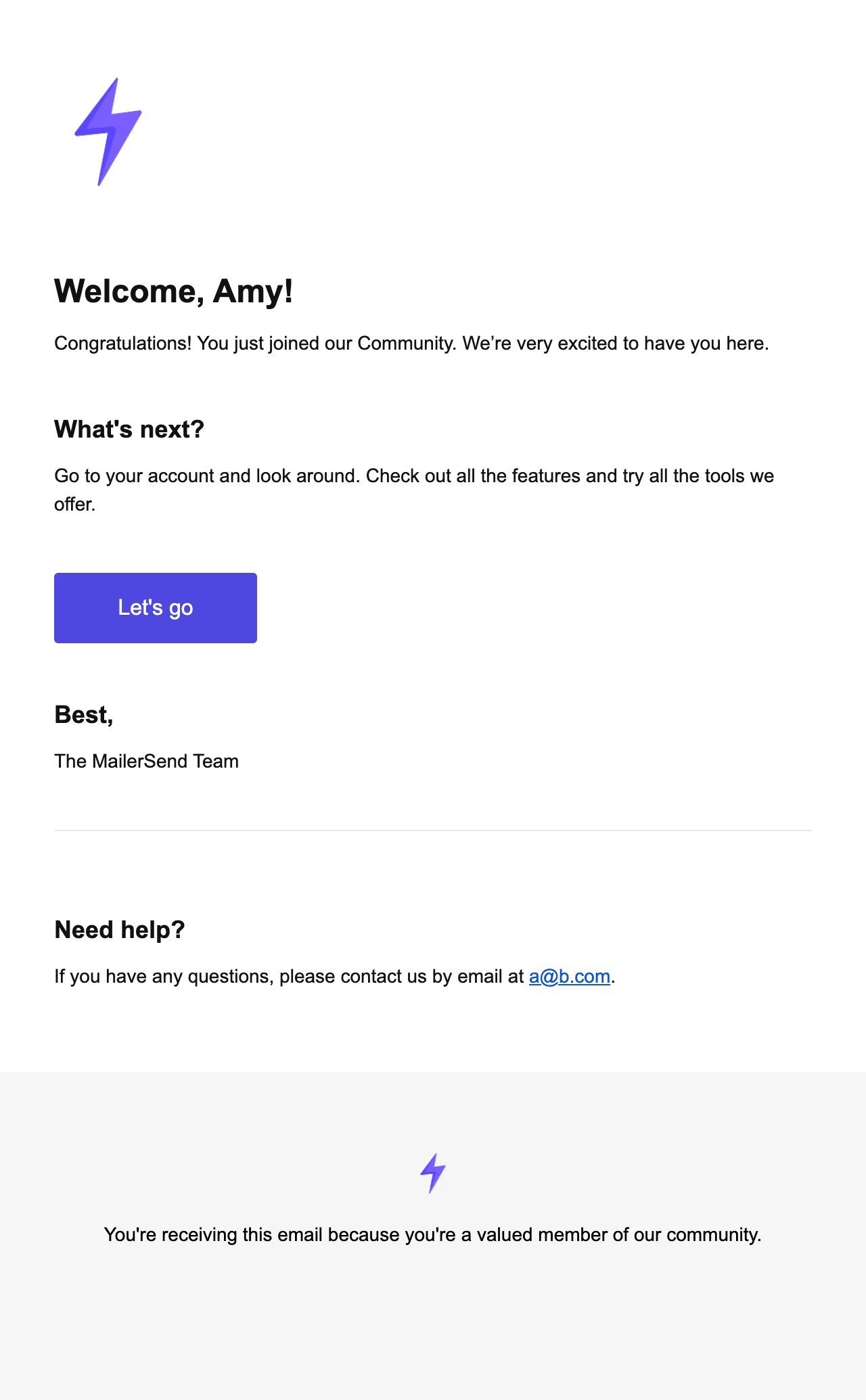
Security emails
Transactional emails that fall under this category are related to the security of the recipient’s account.
Password reset email example
When a recipient requests a password reset, they will receive a password reset email to the email address which is registered to the account. From here, they can click the link in the email and reset their password. The information in these emails is unique and highly sensitive, so an automated request through a transactional email service is needed.
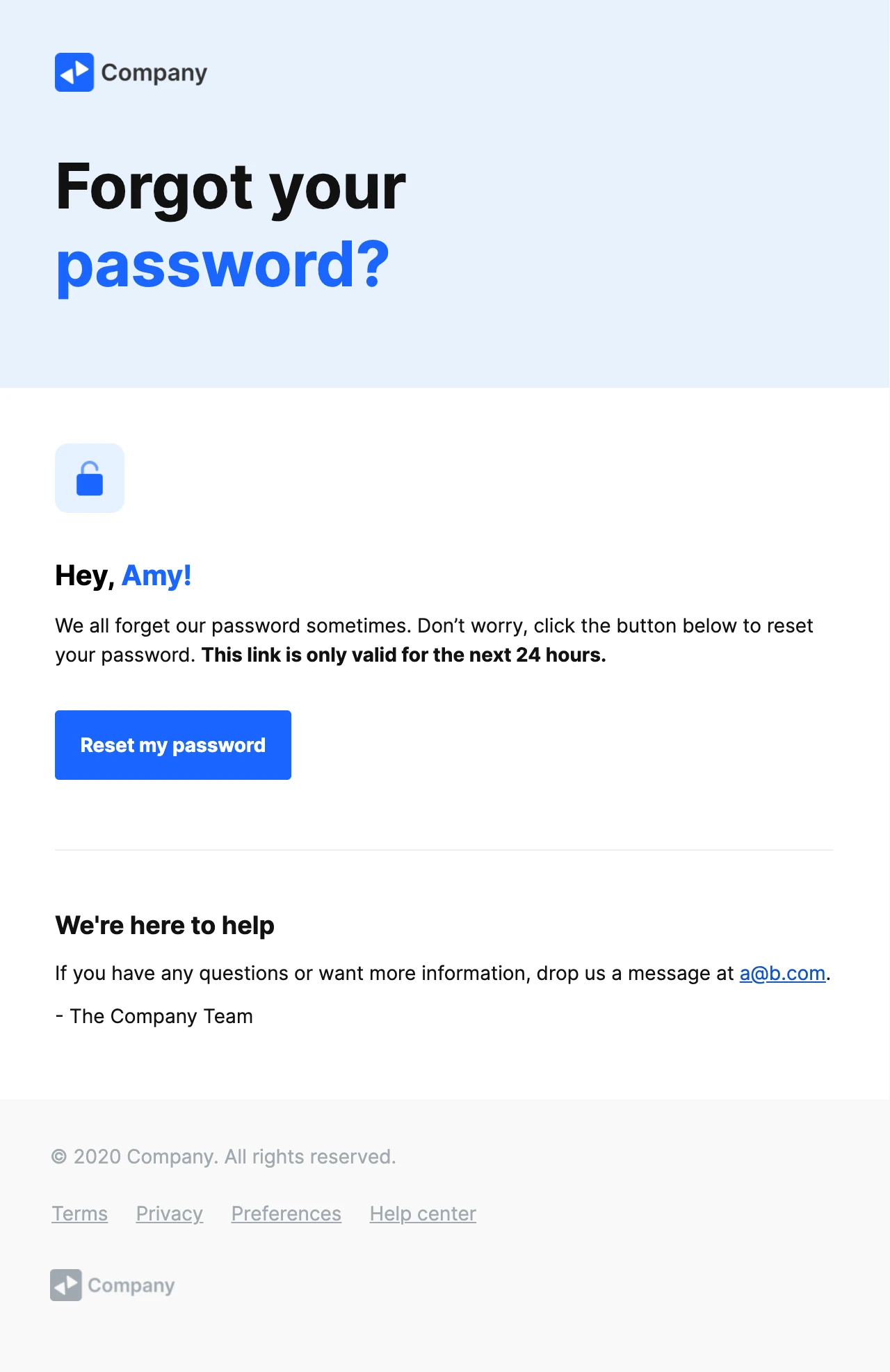
Login verification email example
As an extra layer of security, you may allow recipients to enable 2-factor authentication (2FA). One method of 2FA is to receive a login verification email, like the example below.
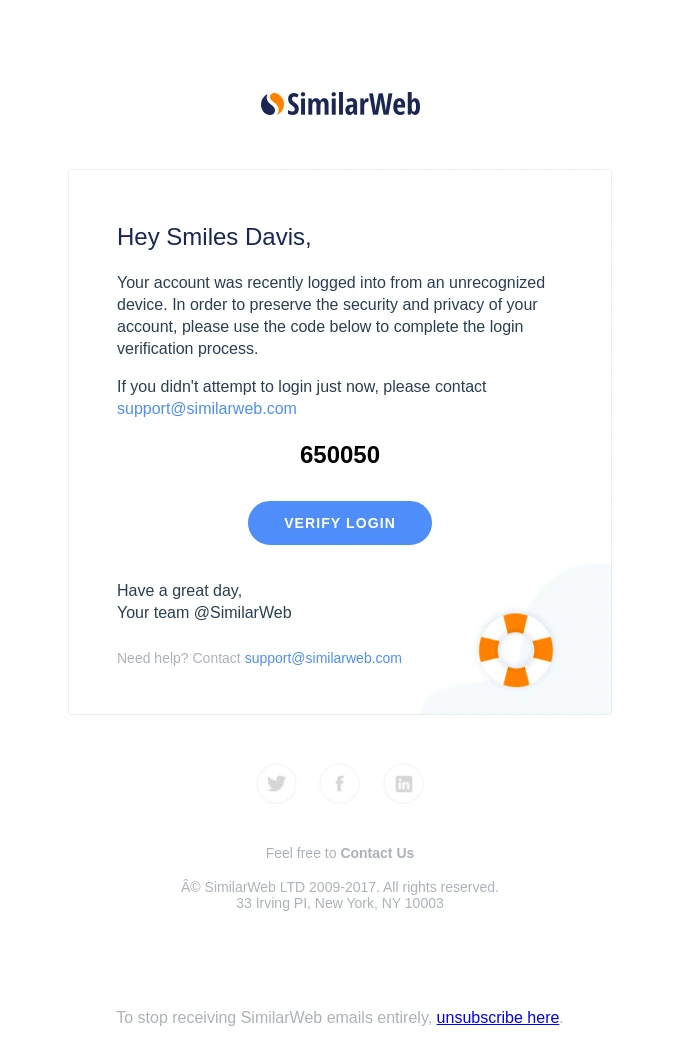
Email verification email example
In order to verify the authenticity of the account creation, a verification email can be triggered to enable the recipient to verify their email address and account.
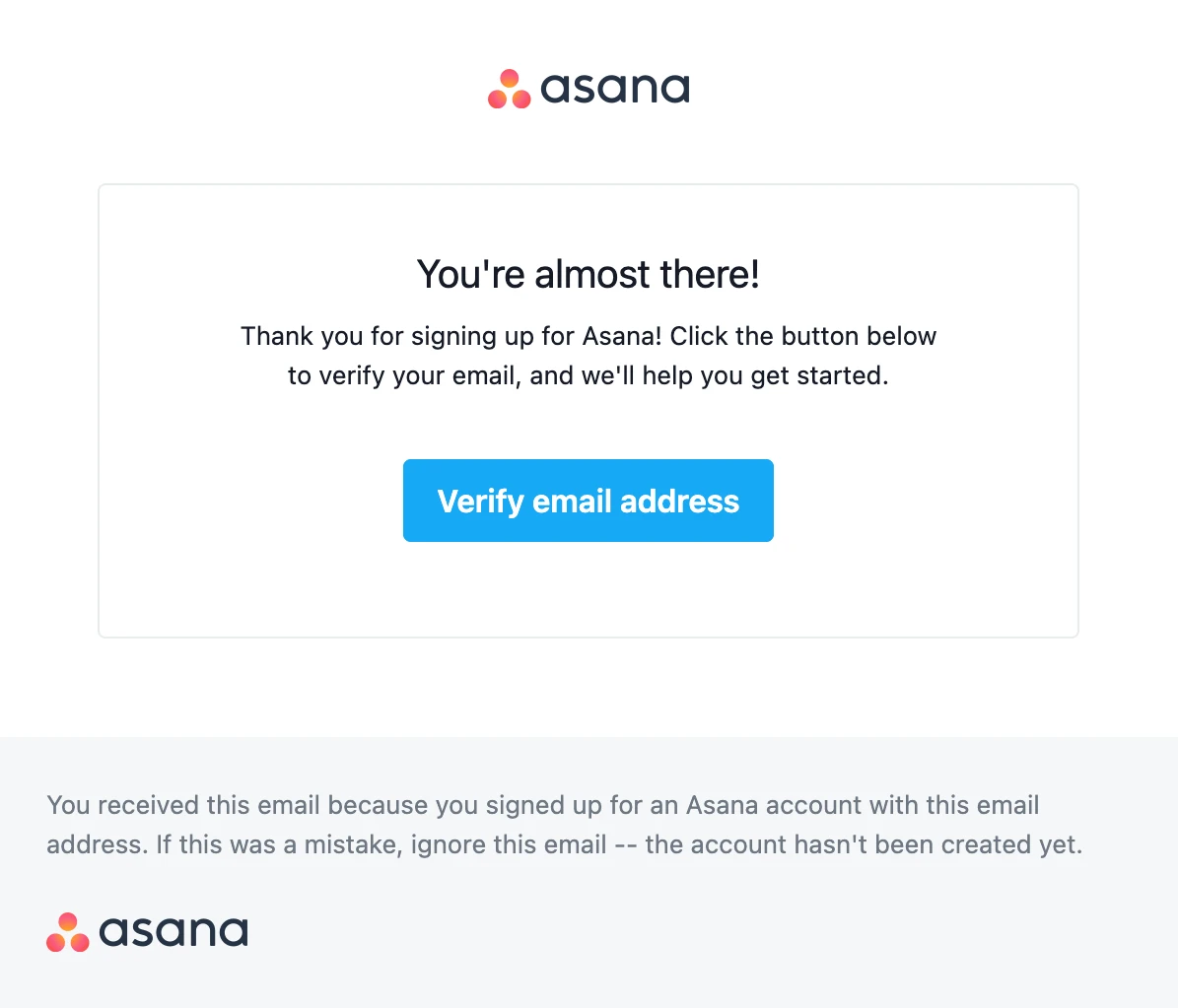
E-commerce and payment emails
This type of transaction email covers everything to do with purchases, orders, shipping and registered interest. Let’s take a look at a few of the different types.
Order confirmation email example
An order confirmation email confirms that the recipient’s order has been received and is being processed. This type of email may also include details of the order and payment information.

Receipt email example
Email receipts confirm that the recipient’s payment has been received and that their order is being processed.

Invoice email example
Invoice emails are similar to receipt emails, but rather than confirm that the payment has been received, they confirm the order details, payment method and billing address.
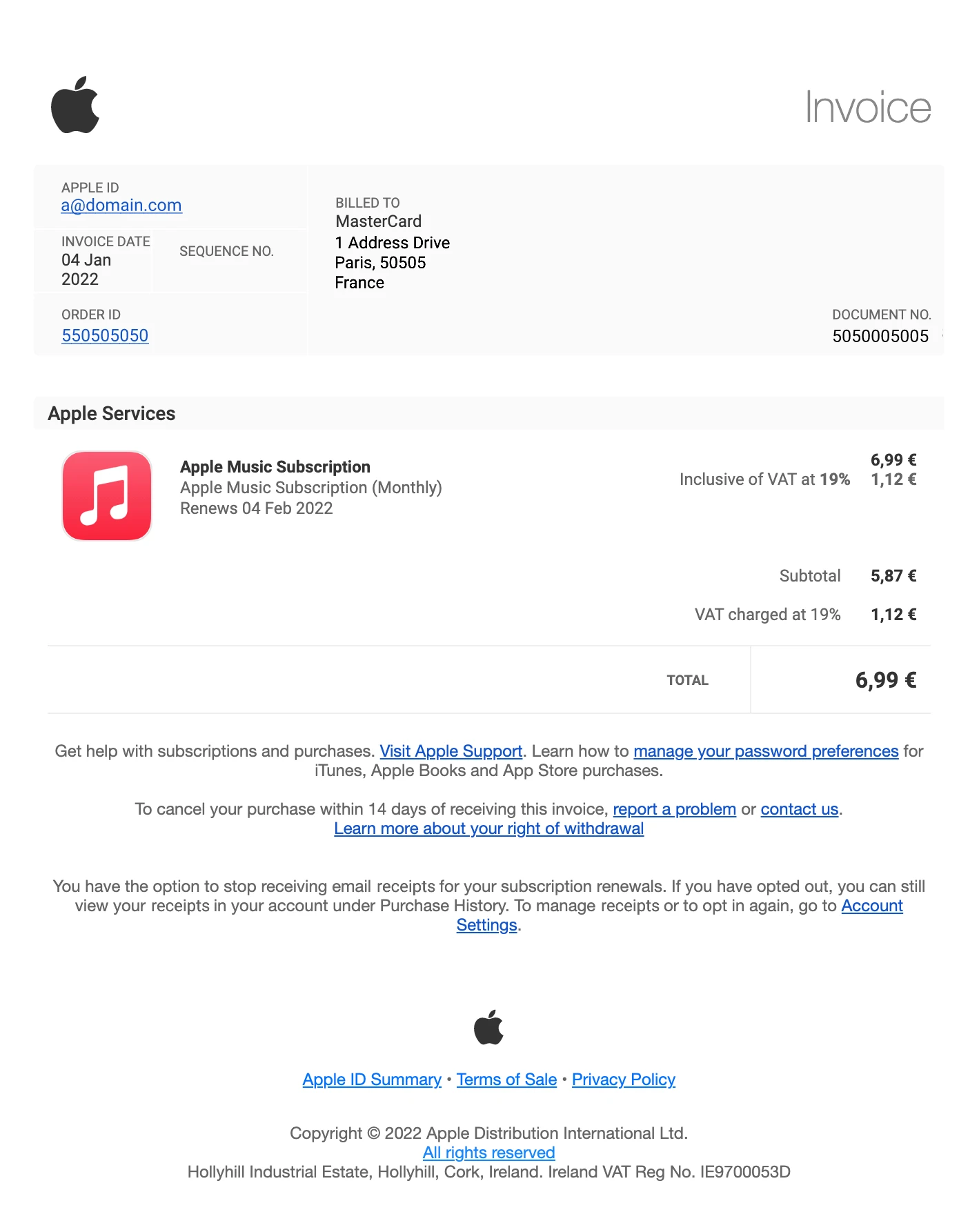
Shipping notification email example
Shipping notifications are transactional emails used to notify the recipient that their order has shipped, and sometimes provide updates on shipping progress. They also often include a unique tracking ID if applicable.
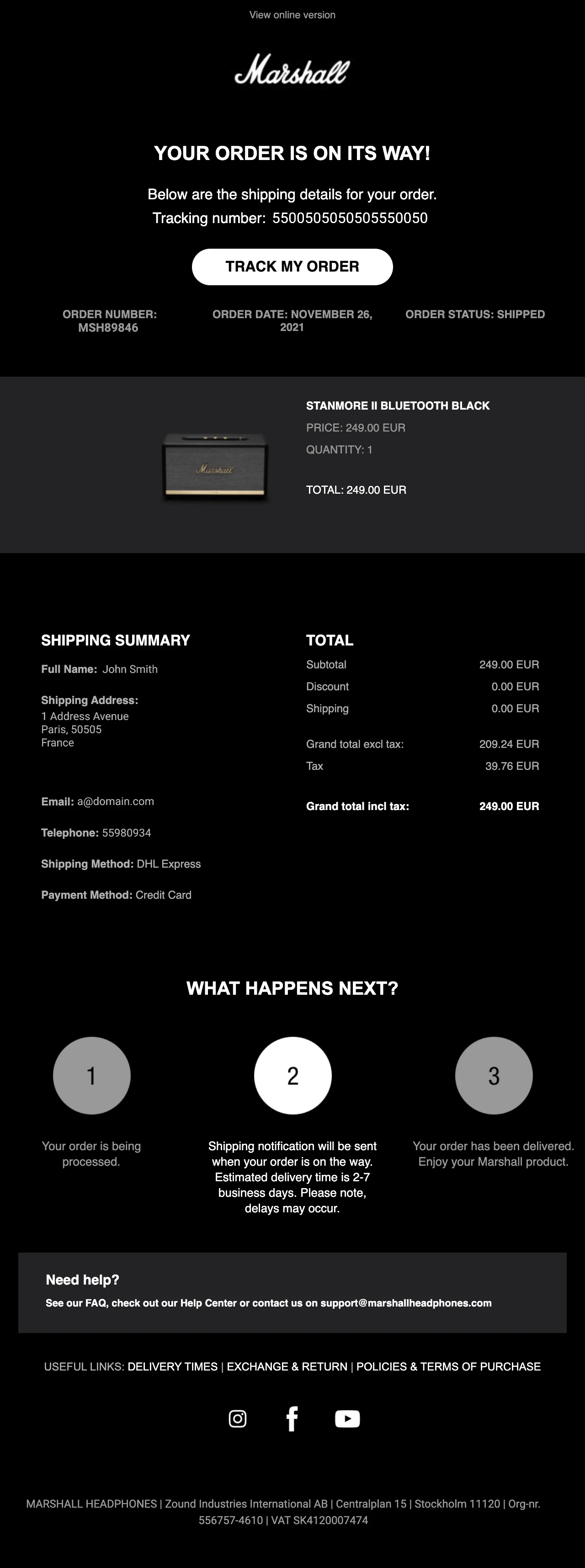
Delivery confirmation email example
These emails are used to confirm that delivery has taken place and to verify that the shipment has been safely delivered to its intended destination.
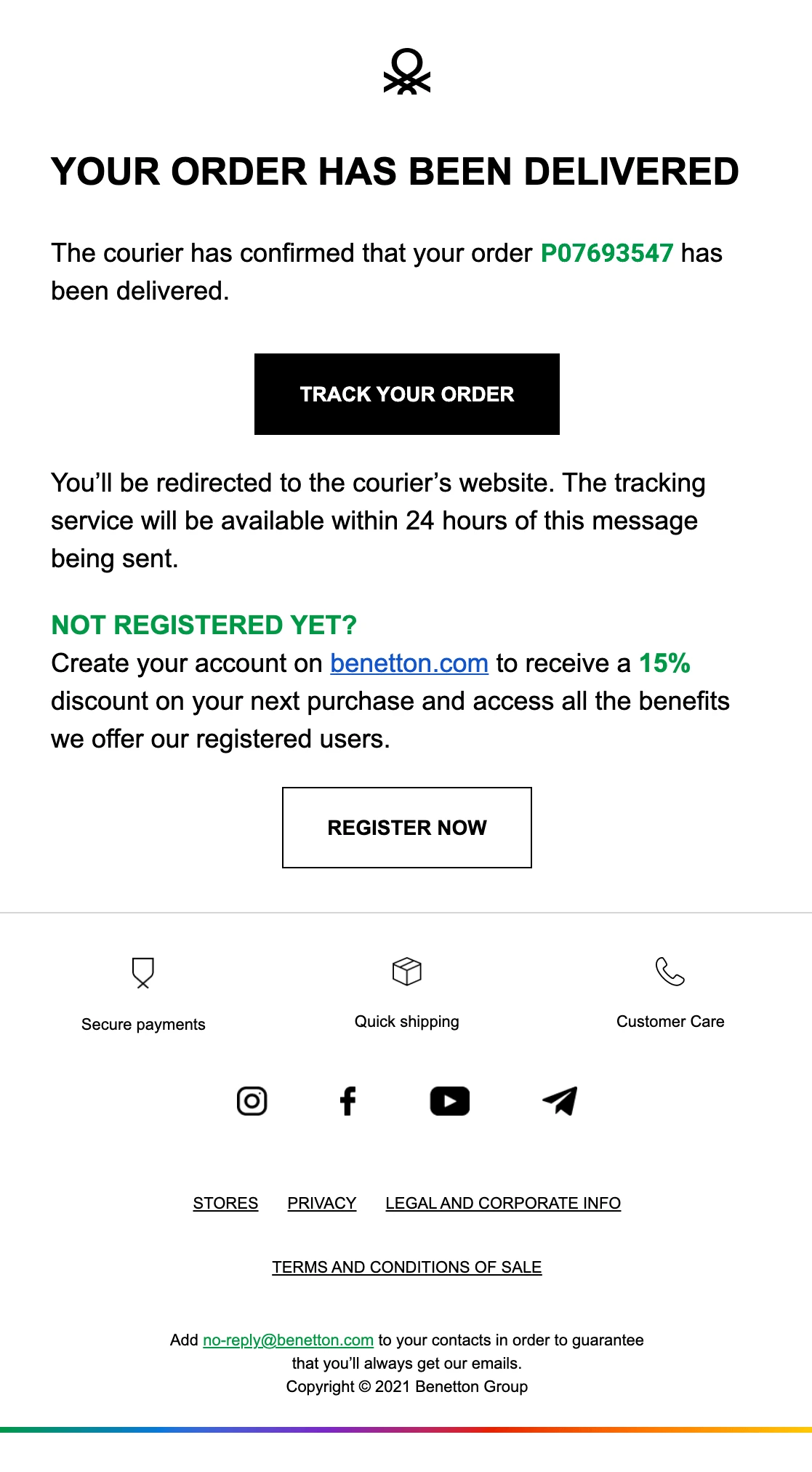
Notification emails
Notification emails are transactional emails that provide information about an update or change to the recipient’s account, activity or an event relevant to their interests. Here are a few examples of notification emails.
Comment notification email example
If you’re a user of social media or Google Docs, you’ve probably received a few comment notification emails before. These emails are used by websites and apps that allow commenting, to inform the recipient of comment activity in relation to their account. This way, they can be redirected back to the website or app to respond.
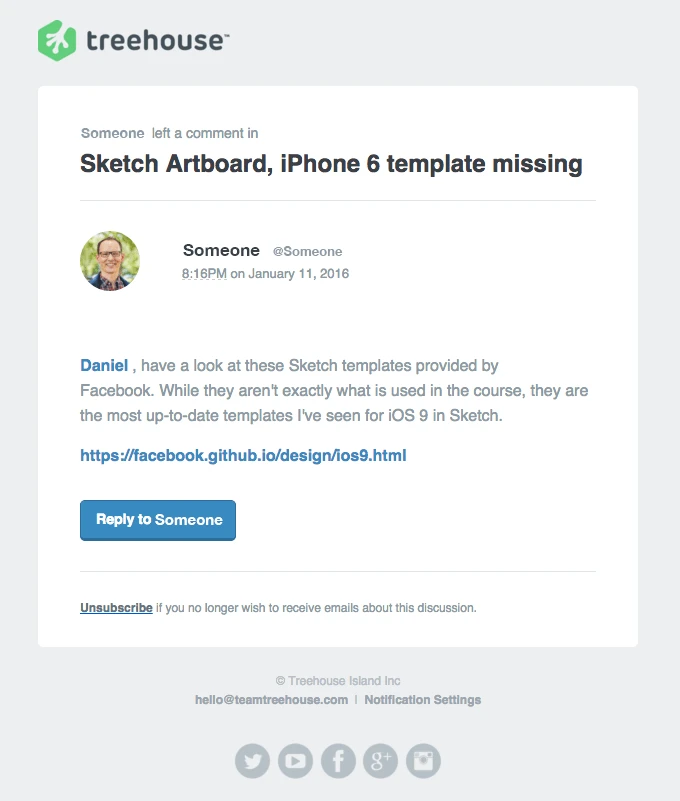
Feedback request email example
Feedback request emails can be triggered when a certain period of time has passed after the recipient has registered, or when they perform an action such as completing a purchase or trying out a new service or feature.

Review reminder email example
If a user has projects or tasks in progress, reminder to review emails might be triggered automatically by certain events or time triggers. These prompt the recipient to head to the website or app to give feedback or resolve issues and comments.
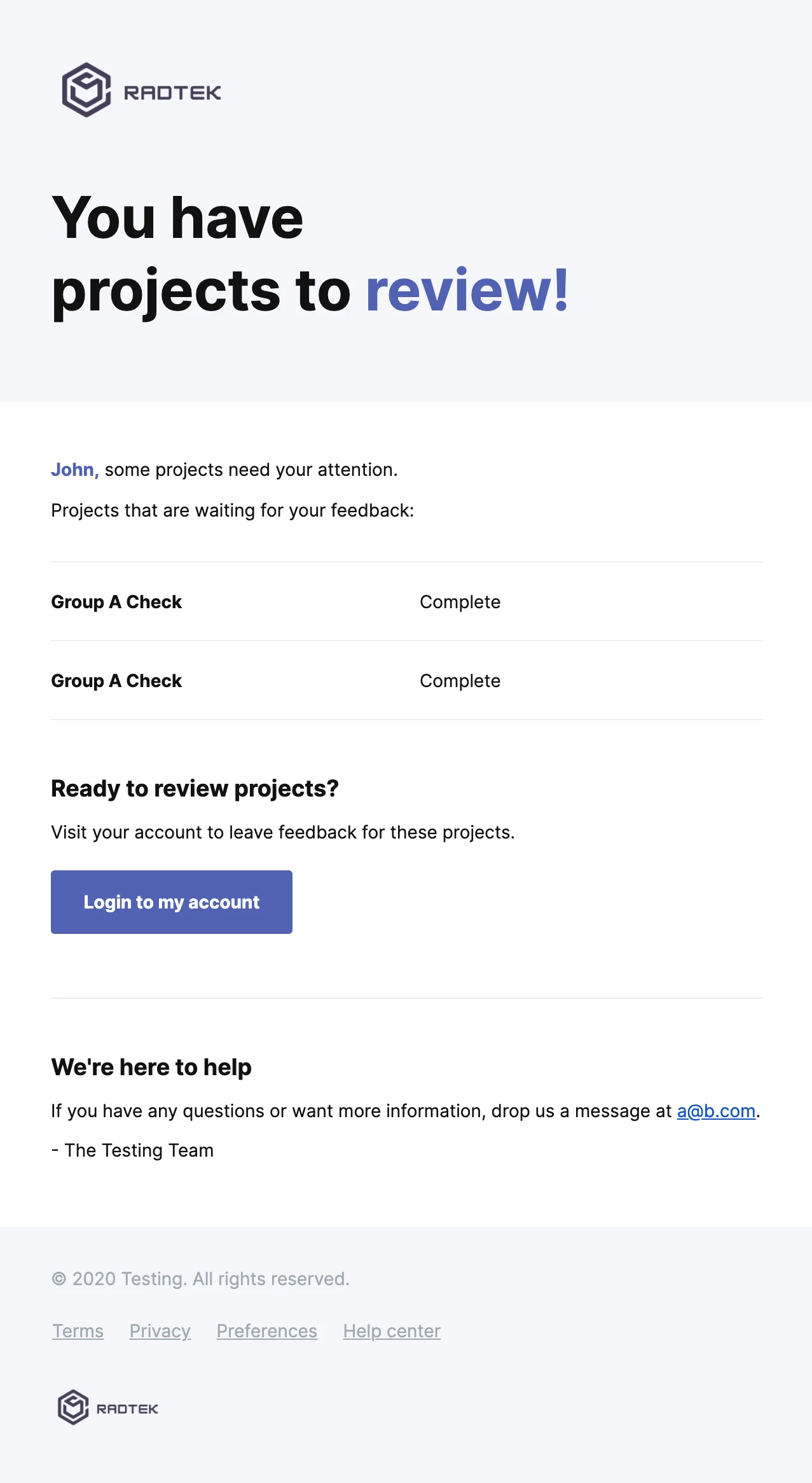
Account notification email example
When a change or update is made to an account, account notification emails inform the recipient without them needing to first log in to the website or app. Some examples of this are:
An action run by the recipient is complete
A new subscriber has signed up to a mailing list
A monthly bill has been paid
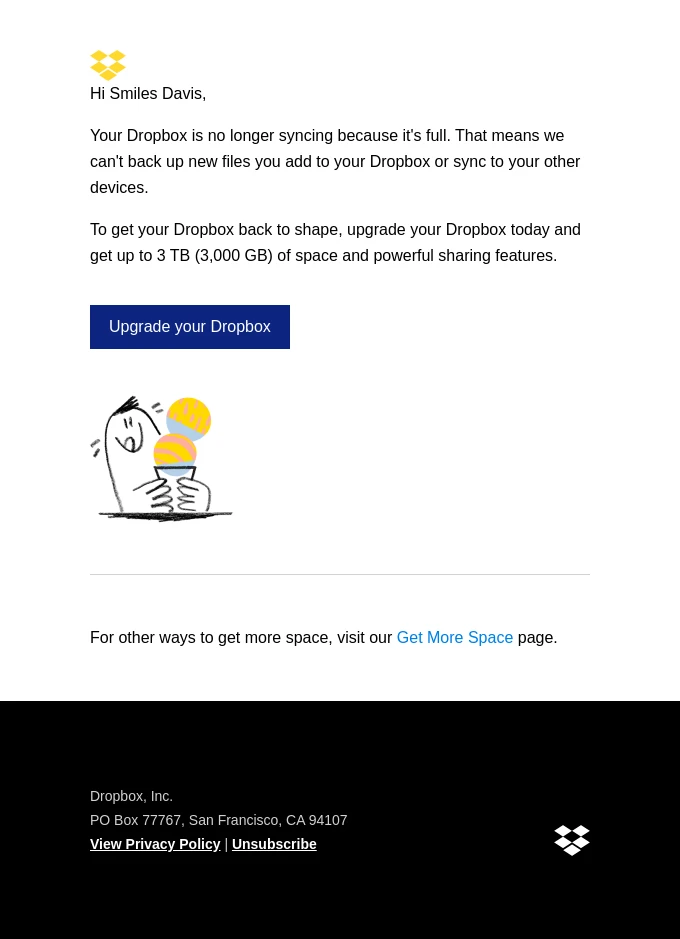
Characteristics of marketing emails
1. Recipients have subscribed to the email list
In contrast to transactional emails, recipients of marketing emails have signed up and opted-in to receive emails that contain commercial content. Subscribers are most commonly collected from signup forms on websites and landing pages. Subscribers can also be collected by opting in separately to marketing emails when they register to use a service.
2. Sent to many recipients simultaneously
Marketing emails are not sent to each individual when they are triggered by an action. Rather, they are sent in bulk to the entire email list, meaning each subscriber receives the same emails at (roughly) the same time.
3. Covered by CAN-SPAM and GDPR
That’s right—if you’re sending marketing emails they must comply with data protection and privacy legislation such as CAN-SPAM and GDPR.
4. Opt-in is required
Recipients of marketing emails MUST have opted in with active consent to receive such communication. This means that businesses need to allow subscribers to actively opt-in, and not opt-out. Double opt-in is preferred to help keep email lists clean.
5. Emails need to contain an unsubscribe link
When it comes to marketing emails, unsubscribe links are a must to comply with various legal standards, provide a friendly user experience, and ensure that email lists are kept clean.
6. Contain general commercial content
Unlike transactional emails, which contain unique content specific to the recipient, marketing emails contain the same content for each recipient as part of a marketing campaign. Learn more about marketing email content.
7. Success metrics
Because marketing emails contain commercial messages, and not important, time-sensitive information such as a password reset link, delivery speed isn’t as important here.
Open rates and click-through rates are just as important for marketing emails, but the benchmarks for success are set much lower with an average open and click-through rate of around 20% and 2% respectively. This is because, as the recipient hasn’t triggered the email and doesn’t need anything from it, they are much less likely to open it.
8. Must add IPs to an allowlist
Sending IP addresses used to send marketing emails may be blocked on certain networks. In this case, the sending IPs would need to be added to the organization’s allowlist.
Examples of marketing emails
Welcome email example
Didn’t we see welcome emails in the transactional email examples? Yes, we did. But marketing welcome emails are different. Rather than information related to the recipient’s account or registration, they confirm a person’s subscription to the marketing email list and sometimes tell them what to expect from their newsletters or include a special offer.

Newsletter example
Newsletters contain news, service/product updates, new resources, such as blog posts and case studies, and other promotional content.

Promotional/offer email example
If you want to promote an upcoming sale or share a discount code, dedicated promotional emails are the way to go. The goal of these emails is to guide a potential customer along the sales funnel.

Lead nurturing email example
These emails are sent out at just the right time to help you build relationships with your subscribers and guide them through the sales funnel. This will often be a mix of helpful, fun and entertaining content that helps subscribers to see the value in your product or service.

Re-engagement email example
With marketing emails, engagement is key. If you have a bunch of unengaged subscribers, it could negatively impact your sender reputation. But before completely removing them from your email list, a re-engagement campaign could help to win them back.

Review request email example
A review request email campaign is sent out to all subscribers. It’s content would be more general compared to that of a transactional review request, which could be triggered by a purchase of a specific product.
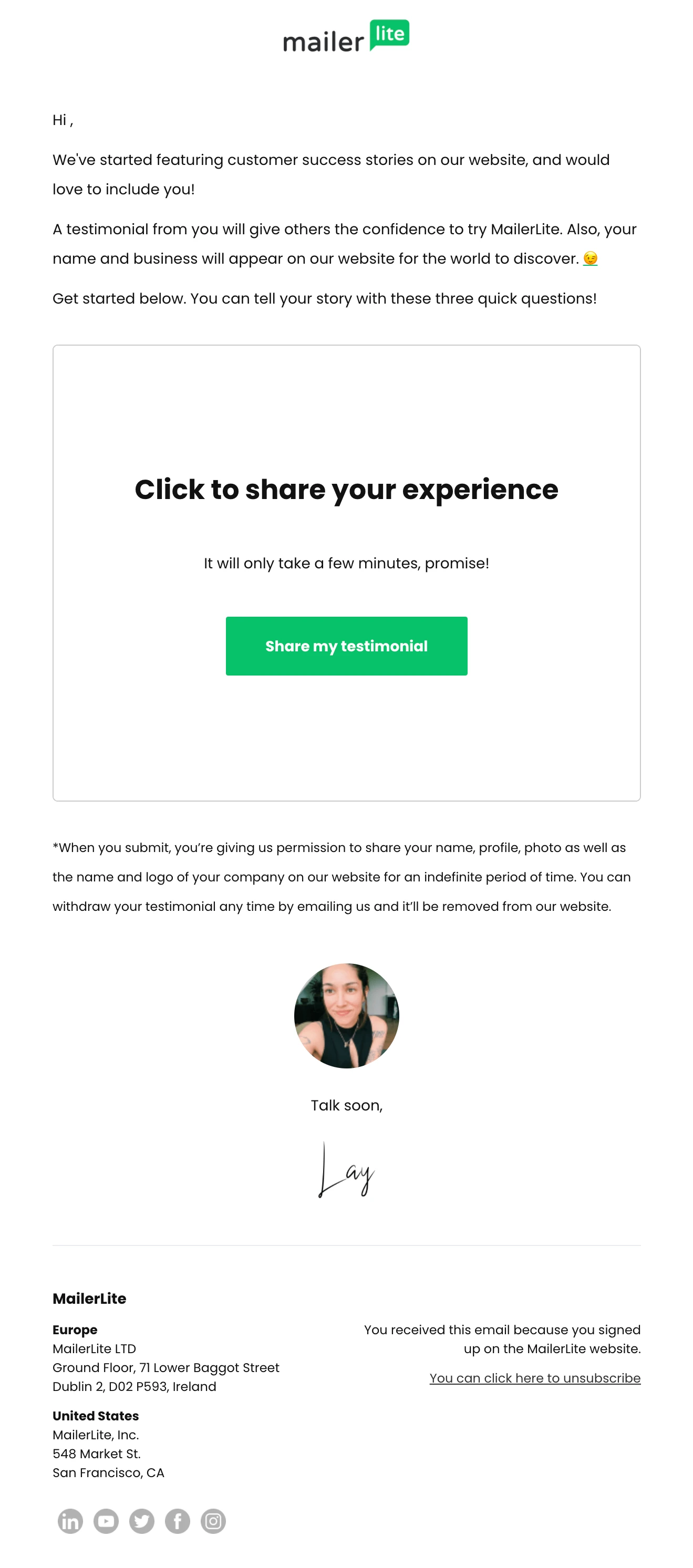
Are you looking for an email marketing tool to take your campaigns to the next level?With MailerLite, anyone can design beautiful and effective marketing emails with the user-friendly drag & drop builder. Even better, with a Zapier integration, you can connect MailerLite with MailerSend to share information about recipients across apps to keep your email list healthy.Learn more about marketing emails.
Why you should use different tools for marketing and transactional emails
Transactional emails and marketing emails have very different goals, content and success metrics. For this reason alone it’s good practice to keep them separate (not to mention it will make managing them easier!).
There are, however, a number of other reasons that using different providers for transactional and marketing emails is essential if you want both to perform optimally.
Deliverability
If you send both transactional emails and marketing emails using the same Email Service Provider (ESP), it’s more difficult for email clients to distinguish between the two. Sending them from separate servers removes the chance everything will be labeled as promotional, allowing transactional emails to be delivered to the inbox in the timely manner that they are supposed to be.
Moreover, open and click rates of marketing emails are much lower than that of transactional emails. Sharing an IP address for both could result in a lower domain reputation, impacting the deliverability of critical transactional emails.
Speed of delivery
A key element in transactional email sending is speed—for transactional emails, it’s not just whether they land in the inbox that’s important (deliverability) but also how quickly they get there. Recipients trigger the email, and usually they expect to see that email in their inbox instantly. If not, it dampens the user experience. Sending large volumes of marketing emails from the same server could result in the delivery of transactional emails being delayed.
Email preferences
Since recipients need to opt-in to marketing emails but not transactional emails, managing both on one platform can become messy. Using different providers for each will give you peace of mind that you’re complying with legislation like the GDPR, and help you avoid any unintentional mistakes that could lead to hefty fines!
Personalization
No, we’re not talking about names. But a deeper level of personalization that makes transactional emails unique to their recipients, such as password reset links, account information, or order details (like in the example below). Marketing ESPs often don’t include the functionality to provide the level of personalization that transactional emails require, so a dedicated solution is necessary.
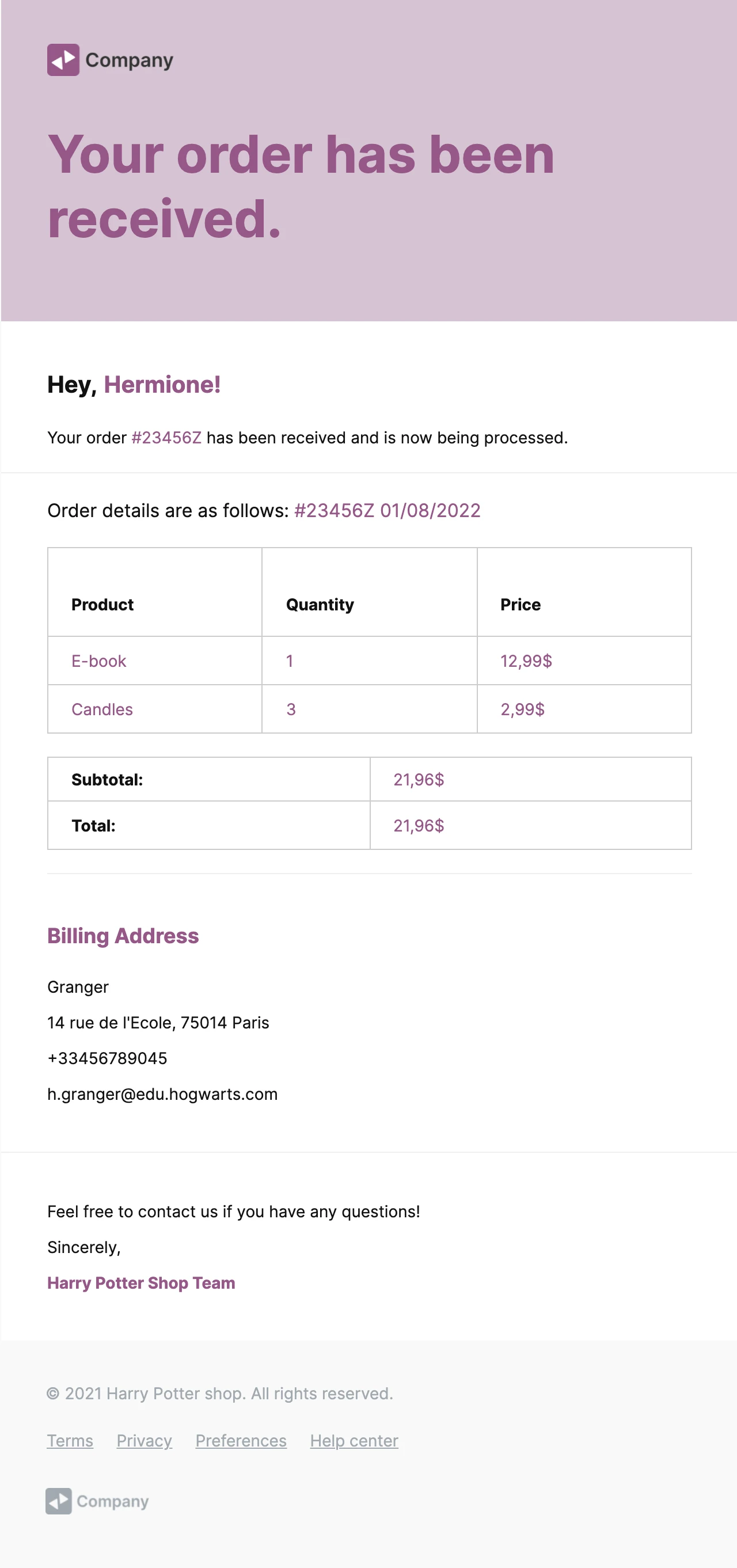
How to separate transactional emails from marketing emails
The goal for transactional emails is speedy delivery every time. To ensure this, email clients need to easily make the distinction between transactional emails and marketing emails. There are a few ways to achieve this:
1. Different “From” email addresses for transactional and marketing emails. For example, transactional emails are sent from info@yourdomain.com and marketing emails from email@yourdomain.com.
2. A dedicated IP address for transactional emails so the message stream can build its own reputation.
3. Different subdomains. For example, transactional emails are sent from info@account.yourdomain.com and marketing emails from email@newsletter.yourdomain.com.
Luckily, by selecting a transactional email service like MailerSend, all of this will be taken care of for you! MailerSend makes setting up and managing your transactional emails simple, and our platform is optimized for maximum email deliverability.
Learn how to set up transactional emails with MailerSend.
- Getting started
- FAQ
-
Features
- Sending domains
- Managing API tokens
- Domain tracking options
- How to add a domain space to your account
- SMTP relay
- Webhooks
- Inbound routing
- Templates
- How to add a survey to your emails
- Email tagging
- File manager
- Email and recipient activity
- Analytics
- Split Testing
- How to use personalization in emails
- How to use the MailerSend iOS app
- Schedule bulk emails with the bulk endpoint
- Ensuring secure SMS communication: Verification and usage limits
- SMS: How to handle opt-in and opt-out
- Custom headers
- Upcoming changes to TLS Protocol support
- How to request a dedicated IP
- How to add a custom unsubscribe header
- Deliverability
- Account settings
- Billing
- Integrations
- What is a transactional email?
- What is a marketing email?
- What's the difference?
- Characteristics of transactional emails
- Examples of transactional emails
- Characteristics of marketing emails
- Examples of marketing emails
- Why you should use different tools to manage them
- How to separate transactional and marketing emails
